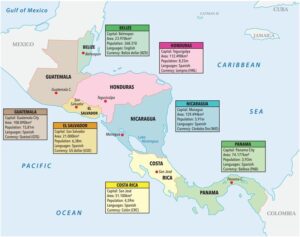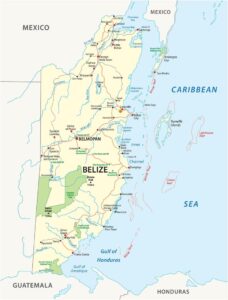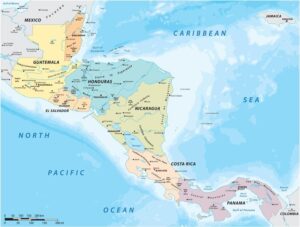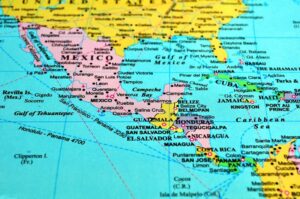Over the decades, the territorial boundaries of Belize have been defined by a rich and contentious historical narrative. You may find yourself pondering why the border between Belize and Guatemala appears as a dashed line on numerous maps, a visual representation of a deeply entrenched territorial dispute. This ongoing conflict stems from historical claims made by Guatemala, which has persistently challenged Belize’s sovereignty since the nation achieved independence. The potential for international tension remains considerable, as both countries actively pursue diplomatic efforts to resolve this boundary issue. Your examination of this geopolitical conundrum uncovers the intricate challenges surrounding national borders in Central America, where colonial legacies and notions of territorial integrity continue to intersect in potentially volatile manners.
Diving Deep into the Historical Claims of the Belize-Guatemala Territorial Dispute
The ongoing territorial conflict between Belize and Guatemala can be traced back to a complex interplay of historical and colonial legacies. This dispute originated during the colonial era, when territorial boundaries were often vaguely delineated and open to varying interpretations. The unresolved border issue has endured for centuries, resulting in persistent tensions between these two neighbouring nations and significantly affecting their diplomatic relations. As such, the historical narratives intertwined with these territorial claims are critical to understanding the present-day dynamics between Belize and Guatemala.

Unpacking Guatemala’s Persistent Territorial Claims Over Belize
It is important to note that Guatemala has consistently asserted a historical claim to territorial rights over Belize, a stance rooted in the Spanish colonial administrative boundaries. You may find it surprising that Guatemala views Belize as part of its original territorial inheritance from the Spanish Empire, thereby challenging the modern borders that were established during British colonial rule. This historical perspective complicates the sovereignty issue and continues to inflame tensions between the two nations, as Guatemala’s claims reflect a deeper struggle over legacy and identity.
Assessing the Implications of Historical Borders in Central America
Since the colonial period, these disputed borders have given rise to significant geopolitical challenges for both nations. It becomes evident how undefined border regions create potential for conflict and diplomatic tensions, which ultimately impact local communities and national sovereignty. Understanding the border dispute reveals complex layers of historical, legal, and territorial dynamics, exposing the implications that extend beyond mere geographical demarcations. These implications encompass economic, cultural, and security risks, with the enduring conflict posing substantial ramifications for regional stability, international law, and the prospects for future negotiations between Belize and Guatemala.
The Meaning Behind the Dotted Line on Maps: A Symbol of Dispute
On various maps, you may notice a distinctive feature: a dotted boundary line separating Belize from Guatemala, symbolising an unresolved territorial dispute that has persisted for decades. This unique cartographic representation signifies a complex geopolitical challenge, where the exact border remains undefined and contested. The dotted line serves as a powerful emblem of ongoing diplomatic tensions and the unresolved territorial claims that have characterised the relationship between these two Central American nations for many years.
The Role of International Recognition in the Unresolved Border Dispute
In the realm of international relations, Belize is acknowledged as a sovereign state with a recognized international presence; however, the disputed border with Guatemala introduces a nuanced geopolitical scenario. You might find it intriguing that while Belize gained independence in 1981, Guatemala has historically questioned its territorial integrity. The dotted line not only signifies geographical uncertainty but also represents an ongoing diplomatic negotiation that continually shapes regional relations and the perceptions of both countries involved in this complex situation.
The Diplomatic Significance of the Dotted Line: A Symbol of Ongoing Negotiation
Beyond its representation on maps, the dotted line acts as a diplomatic symbol of considerable importance. You can interpret it as a visual manifestation of unresolved territorial claims, signalling to the international community the intricate negotiations between Belize and Guatemala. This unique border marking communicates the ongoing dialogue and the potential for a peaceful resolution of the conflict. However, the dotted line signifies more than just a cartographic curiosity; it embodies a delicate diplomatic instrument that helps avert potential military escalation while maintaining an open channel for negotiation.
This line functions as a strategic buffer, allowing both nations to preserve diplomatic relations while working towards a possible future resolution. Its existence exemplifies how international borders can be managed through peaceful means, illustrating a sophisticated approach to territorial disputes that prioritises dialogue over confrontation.

Examining Key Conflicts and Diplomatic Agreements Between Belize and Guatemala
The territorial disputes between Belize and Guatemala are deeply rooted in history, characterised by complex diplomatic tensions and unresolved boundary claims. You will discover that the ongoing disagreement revolves around competing interpretations of colonial-era treaties and the concept of territorial sovereignty. This dispute carries far-reaching implications for both nations, involving potential land ownership challenges and regional geopolitical dynamics that persistently shape their relationship.
The Impact of the 1859 Treaty and Its Consequences
Prior to the signing of the 1859 treaty between Britain and Guatemala, territorial boundaries within the region were ambiguous and hotly contested. It is essential to understand that this agreement aimed to establish clear borders; however, subsequent interpretations have led to ongoing disputes. Guatemala consistently contests the validity of the treaty, arguing that Britain failed to fulfil certain commitments regarding infrastructure development, which has become a central point of contention in their territorial disagreement.
International Court of Justice's Role and Recent Diplomatic Efforts
Recent diplomatic initiatives have focused on resolving the long-standing border dispute through international legal avenues. You will note that both nations have agreed to present their case to the International Court of Justice (ICJ) for a binding resolution. This approach signifies a significant step towards peaceful conflict resolution and the potential for the normalisation of bilateral relations.
In addition to the ICJ proceedings, it is important to recognise the complex diplomatic negotiations that have occurred. The potential referendum in both countries to validate the ICJ’s decision represents a unique method for resolving territorial disputes. Your understanding of this process highlights the delicate diplomatic efforts aimed at maintaining regional stability and resolving historical territorial claims through peaceful, internationally recognised mechanisms.
Gaining Insight into the Current Situation and Travel Considerations for Tourists
Many travellers are fascinated by Belize’s unique border configuration with Guatemala. The ongoing territorial dispute has created a complex geopolitical landscape that affects travel and border crossings. Despite the existing tensions, tourists continue to visit both countries, carefully navigating the delicate diplomatic situation while considering international boundaries and local regulations.
Essential Guidelines for Safely Crossing the Belize-Guatemala Border
When planning international travel to Belize, it is crucial to prepare thoroughly and consider these important guidelines:
- Always ensure you carry a valid passport and any necessary travel documentation.
- Check the current status of diplomatic relations before embarking on your journey.
- Obtain appropriate travel insurance to safeguard your trip.
- Stay well-informed about border crossing procedures to prevent complications.
The most vital aspect is to maintain awareness of your surroundings and respect local regulations to ensure a smooth and enjoyable travel experience.
Community Perspectives: Local Sentiments Surrounding the Dispute
Beneath the surface of the border dispute lie deep-rooted historical tensions and intricate cultural dynamics. Communities situated near the border experience the direct impacts of the dispute, with generational memories of conflict significantly shaping their perspectives. Residents often find themselves balancing national pride with a desire for peaceful coexistence, highlighting the human element embedded in this geopolitical issue.
Gaining Deeper Insights into Community Dynamics and Cultural Identity
To truly understand the local perspective, it is important to explore the nuanced landscape of cultural identity. You will discover that border communities have developed unique survival strategies, blending resilience with diplomatic pragmatism. Indigenous groups, in particular, play a critical role in maintaining cross-border relationships, often transcending official diplomatic tensions through grassroots connections and shared cultural experiences, fostering a sense of unity amid conflict.

Evaluating the Future Implications of the Belize-Guatemala Border Dispute
Despite the ongoing territorial dispute, there remains potential for significant geopolitical shifts. The unresolved border issue between Belize and Guatemala continues to foster tensions, with implications that could redefine diplomatic relations within Central America. You may observe that resolving this dispute could have profound impacts on regional stability, economic collaboration, and the international perceptions of both nations involved.
Continuing the Dialogue: Opportunities for Resolution Between Belize and Guatemala
Dialogue remains the primary mechanism for addressing the territorial disagreement. You will find that both countries have engaged in diplomatic negotiations, seeking peaceful resolutions through international platforms such as the Organization of American States (OAS). These discussions reflect a commitment to avoiding military confrontation and finding a mutually acceptable solution to their long-standing border dispute, emphasising the importance of dialogue in conflict resolution.
Exploring Potential Pathways Towards a Lasting Resolution
Above all, it is crucial to understand that multiple strategies exist for resolving the border conflict. International mediation and bilateral negotiations present promising avenues for progress. You might consider approaches such as joint territorial management, referendums, or interventions from international courts as viable methods to effectively address the dispute.
The implications of resolving this conflict extend well beyond simple border demarcation. You will discover that successful negotiations could unlock significant economic opportunities for both Belize and Guatemala. Potential benefits could encompass enhanced trade, improved cross-border cooperation, and increased foreign investment. The most transformative outcome would be the establishment of permanent territorial sovereignty, which could dramatically reduce regional tensions and foster long-term stability in Central America.
Understanding the Regional Dynamics of the Belize-Guatemala Conflict
Unlike other border disputes in Central America, the Belize-Guatemala territorial conflict is steeped in deep historical complexities that have significantly shaped regional geopolitical interactions. You will find that this longstanding disagreement reflects broader patterns of territorial tension, involving colonial legacies, post-independence territorial claims, and intricate diplomatic negotiations that have profoundly influenced the political landscape of the region.
Assessing the Impact of the Dispute on Central American Relations
After decades of territorial disputes, you can observe how this conflict has strained diplomatic relationships between Belize and Guatemala. The ongoing tension has periodically disrupted regional cooperation, creating challenges for economic integration and mutual understanding within the larger Central American community.
The Role of International Organisations in Mediation Efforts
With diplomatic mediation playing a critical role, international organisations have actively participated in efforts to resolve the border dispute. You will notice that entities like the Organization of American States (OAS) have been instrumental in facilitating dialogue and proposing viable resolution strategies.
A comprehensive network of international organisations has been strategically involved in addressing the Belize-Guatemala border dispute. The United Nations, OAS, and various diplomatic channels have worked tirelessly to prevent escalation, offering mediation services and promoting peaceful negotiation. You will appreciate how these organisations have helped to maintain stability, providing a structured approach to resolving territorial disagreements and mitigating potential military confrontations.
Reflecting on the Complexities of the Belize-Guatemala Border Dispute
As we weave together the complex threads of Belize’s territorial history, it becomes evident how the nation’s border with Guatemala serves as a testament to unresolved colonial legacies. As you delve into this geopolitical puzzle, you will understand that the dotted border represents more than a mere cartographic curiosity; it embodies ongoing diplomatic negotiations and historical tensions. Your comprehension of this dispute reveals the intricate challenges that post-colonial states face, where territorial boundaries continue to ignite international dialogue. The unresolved status underscores the delicate balance between historical claims and modern diplomatic resolutions, inviting you to appreciate the nuanced complexity of international border disputes.

Frequently Asked Questions Regarding the Belize-Guatemala Border Dispute
What is the reason behind the dotted border between Belize and Guatemala?
The dotted border signifies a long-standing territorial dispute between Belize and Guatemala, originating from conflicts that date back to the colonial era. Initially, Spain claimed the territory, and after Belize gained independence from Britain in 1981, Guatemala continued to assert its territorial claims, leading to an undefined border demarcation depicted by the characteristic dotted line on maps.
Has the border dispute between Belize and Guatemala reached a resolution?
The dispute remains partially unresolved; however, significant progress has been achieved. In 2019, both countries agreed to submit the territorial disagreement to the International Court of Justice (ICJ) for a binding resolution. A referendum in both nations endorsed this approach, indicating a diplomatic pathway towards definitively settling the border controversy.
What are the historical origins of the border conflict between Belize and Guatemala?
The conflict originates from the 1859 treaty between Britain and Guatemala, which promised infrastructure development in exchange for territorial recognition. When Britain failed to fully meet these commitments, Guatemala began to challenge Belize’s territorial integrity. This historical misunderstanding has perpetuated decades of tension, as Guatemala continues to maintain claims over approximately 53% of Belize’s current national territory.
The Article Why Is Belize’s Border Dotted? Exploring the Guatemala Dispute appeared first on Belize Travel Guide
The Article Belize’s Border Dotted: Unraveling the Guatemala Dispute Was Found On https://limitsofstrategy.com


Your exploration of the Belize-Guatemala territorial dispute opens up a fascinating avenue for discussion about how colonial histories have lasting effects on contemporary borders and national identities. It’s really intriguing to think about how a dashed line on a map can symbolize so much more than just a geographical boundary—it highlights a complex tapestry of historical grievances, cultural connections, and political negotiations that continue to play out in our global society.
You’ve touched on a really deep and often overlooked aspect of territorial disputes. The way colonial histories continue to shape our present is something we might not always consider in everyday conversations. Your observation helps to unravel the notion that borders are just lines on a map; they carry the weight of histories, conflicts, and often unresolved traumas.
I’m glad you found the discussion engaging! If you’re interested in exploring more about how historical legacies shape modern geopolitics, I invite you to read further on this topic [here].
https://littletonauction.com/consult
You’ve hit the nail on the head with that observation. It’s wild how a simple line on a map can carry so much emotional and historical baggage. The Belize-Guatemala dispute has roots that are tangled like a pair of old earbuds—each twist and knot representing years of colonial meddling and national identity crises.